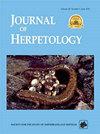Diversity and Sexual Dichromatism in Treefrog Throat Coloration: Potential Signal Function?
IF 0.8
4区 生物学
Q3 ZOOLOGY
引用次数: 2
Abstract
Abstract. Sexual dichromatism, where males and females of the same species differ in coloration, is best studied in diurnal animals. Nocturnal animals such as frogs do not seem good candidates for widespread sexual dichromatism, or for the use of visual signals in social communication in general. Yet, up to 25% of treefrog species (Anura: Hylidae) show some degree of sexual difference in their dorsal coloration. The ventral side of frogs is hidden during rest, but the throat region becomes visible in active individuals, especially in calling males. We compiled a database of 249 treefrog species that include members of all seven subfamilies of the Family Hylidae. We document that the throat region of male frogs is frequently colorful and of a different color than the abdomen (ventral dichromatism), that there is interspecific variation in throat coloration, and that males and females differ in throat coloration (sexual dichromatism). We also examined intraspecific variation in throat coloration, using Eastern Gray Treefrogs, Dryophytes versicolor (Hyla versicolor) as the focal species. Here, we document throat color is sexually dimorphic, that it varies among males, is associated with better body condition, and on average is darker in mated compared to unmated males. Our study finds that throat color dichromatism is the most prevalent type of sexual dichromatism in treefrogs, and that throat coloration may have sexual signal function.三色喉着色的多样性和性重色性:潜在信号功能?
摘要性别二色性,即同一物种的雄性和雌性在颜色上不同,在昼行动物中得到了最好的研究。像青蛙这样的夜行动物似乎不适合广泛的两性二色性,也不适合在一般的社会交流中使用视觉信号。然而,高达25%的树蛙(无尾目:水螅科)在背色上表现出一定程度的性别差异。青蛙的腹侧在休息时是隐藏的,但喉咙区域在活动的个体中是可见的,特别是在鸣叫的雄性。我们编制了一个包含水螅科所有7个亚科的249种树蛙的数据库。我们记录了雄性青蛙的喉咙区域经常是彩色的,并且与腹部的颜色不同(腹侧二色),喉咙颜色存在种间差异,雄性和雌性喉咙颜色不同(性二色)。我们还研究了喉色的种内变异,以东部灰树蛙为焦点种,斑点干藓(Hyla versicolor)。在这里,我们记录了喉咙的颜色是两性二态的,它在雄性之间是不同的,与更好的身体状况有关,平均而言,交配的雄性比未交配的雄性颜色更深。我们的研究发现,喉色二色是树蛙中最普遍的性别二色,喉色可能具有性信号功能。
本文章由计算机程序翻译,如有差异,请以英文原文为准。
求助全文
约1分钟内获得全文
求助全文
来源期刊

Journal of Herpetology
生物-动物学
CiteScore
1.60
自引率
0.00%
发文量
45
审稿时长
6 months
期刊介绍:
The Journal of Herpetology accepts manuscripts on all aspects on the biology of amphibians and reptiles including their behavior, conservation, ecology, morphology, physiology, and systematics, as well as herpetological education. We encourage authors to submit manuscripts that are data-driven and rigorous tests of hypotheses, or provide thorough descriptions of novel taxa (living or fossil). Topics may address theoretical issues in a thoughtful, quantitative way. Reviews and policy papers that provide new insight on the herpetological sciences are also welcome, but they must be more than simple literature reviews. These papers must have a central focus that propose a new argument for understanding a concept or a new approach for answering a question or solving a problem. Focus sections that combine papers on related topics are normally determined by the Editors. Publication in the Long-Term Perspectives section is by invitation only. Papers on captive breeding, new techniques or sampling methods, anecdotal or isolated natural history observations, geographic range extensions, and essays should be submitted to our sister journal, Herpetological Review.
 求助内容:
求助内容: 应助结果提醒方式:
应助结果提醒方式:


